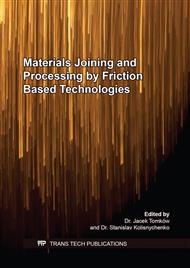[1]
Copyright certificate A.S. 195846 USSR, Cl. IPC V 23 K. Method of welding metals by friction, Yu.V. Klimenko; publ. 01/01/1967, Bul. no. 10 (priority 09.11.1965).
Google Scholar
[2]
W.M. Thomas, C.J. Dawes, et al., Friction Stir Butt Welding, International Patent Application PCT/GB92/02203 and G.B. Patent Application 9125978.8, Dec (1991).
Google Scholar
[3]
A.G. Boitsov, V.V. Kachko, and D.N. Kuritsyn, High-speed welding by friction mixing of aviation materials and constructions, Metalloobrabotka, no. 56 (77–78), 2013, p.35–42.
Google Scholar
[4]
D.N. Kuritsyn, Friction stir welding: investigation of the influence of technological factors on the quality of joints, development of equipment, Saarbrücken, Deutschland: LAP LAMBERT Academic Publishing, 2013, 162 p.
Google Scholar
[5]
V.V. Kuritsyna, and D.N. Kuritsyn, Objects of aerospace production: Introduction to the specialty «Aircraft engines», Saarbrücken: LAP LAMBERT Academic Publishing, 2014, 180 p.
Google Scholar
[6]
FSW Technical Handbook, ESAB AB, Welding Automation, SE-695 81 LAXÅ, Sweden, 2012, 52.
Google Scholar
[7]
A.G. Boitsov, V.V. Kachko, and D.N. Kuritsyn, Technological capabilities and special equipment of high-speed friction stir welding of aviation materials and constructions, Spravochnik, Inzhenernyy zhurnal s prilozheniyem, no 8 (209), 2014, pp.9-17.
DOI: 10.14489/hb.2014.08.pp.009-017
Google Scholar
[8]
A.G. Boitsov, D.N. Kuritsyn, and L.V. Denisov, Optimization of the form and manufacturing technology of a complex profile tool for friction stir welding, ENGINEERING TECHNO 2014: Coll. tr. II Intern. scientific-practical Conf., Saratov: «Rayt-Ekspo» Publishing House, vol. 2, 2014, pp.146-154.
Google Scholar
[9]
D.N. Kuritsyn, L.V. Denisov, A.S. Piskarev, and A.G. Boitsov, Technologies and specific equipment for high-speed friction welding with mixing of metal structures, Tr. Gos. Nauchno-Issled. Tekhnol. Inst. Remonta Ekspl. Trakt. S-kh Mash., vol. 122, 2016, p.194–200.
Google Scholar
[10]
A.G. Boitsov, D.N. Kuritsyn, M.V. Siluyanova, and V.V. Kuritsyna, Friction Stir Welding in the Aerospace Industry, Russian Engineering Research, vol. 38, no. 12, 2018, p.1029–1033.
DOI: 10.3103/s1068798x18120043
Google Scholar
[11]
A.G. Boitsov, D.N. Kuritsyn, and L.V. Denisov, Technological schemes of electroerosive processing of a complex profile tool for welding by friction mixing, Vestn. Mosk. Aviats. Tekhnol. Inst., no. 23 (95), 2014, p.99–110.
Google Scholar
[12]
A.G. Boitsov, M.V. Siluyanova, and V.V. Kuritsyna, Electric-Discharge Milling of Small Airplane-Engine Components, Russian Engineering Research, vol. 38, no. 7, 2018, p.552–556.
DOI: 10.3103/s1068798x18070031
Google Scholar
[13]
V.V. Kuritsyna, and D.N. Kuritsyn, Automation Expert Assessment in the Procedure of Technological Audit of Industrial Enterprises, European Science and Technology [Text] : materials of the XI international research and practice conference, Munich, October 21th – 22th, 2015 publishing office Vela Verlag Waldkraiburg, Munich, Germany, 2015, pp.92-101.
Google Scholar
[14]
M.V. Siluyanova, V.V. Kuritsyna, and P.A. Iosifov, Strategii, metody i modeli upravleniya tekhnologicheskim razvitiem proizvodstv aviatsionno-kosmicheskogo mashinostroeniya (The Strategies, Methods, and Models for Control of Technological Development of Industrial Aerospace Machine Engineering), Moscow: Mosk. Aviats. Inst., (2016).
Google Scholar
[15]
M.V. Siluyanova, and V.V. Kuritsyna, The choice and method of forming a rational integrated design and technological solutions for gas turbine engines, Konkurentnosposobn. Global, Mire: Ekon., Nauka, Tekhnol., vol. 2, no. 2, 2017, p.106–109.
Google Scholar
[16]
V.V. Kuritsyna, M.V. Siluyanova, and D.N. Kuritsyn, Tools for information support of technological audit of high-tech industries, Coll. of scientific papers of the International Scientific and Technical Conference Informatics and Technology. Innovative technologies in industry and computer science,; Moscow University of Technology, Institute of Physics and Technology, Issue 2 (XXII), M.: 2016, pp.332-335.
Google Scholar
[17]
V.V. Kuritsyna and D.N. Kuritsyn, Use of MatLab-Simulink tools for expert evaluation of technological systems by the quality of products of precise machine engineering, Tr. Vseross. Nauchno-Issled. Inst. Mekh. Selsk. Khoz., vol. 124, no. 1, 2016, p.105–111.
Google Scholar
[18]
M.V. Siluyanova, V.V. Kuritsyna, and V.A. Boytsov, Modeli i metody tekhnologicheskogo audita naukoyemkikh proizvodstv (Models and methods of technological audit of high-tech industries), Moscow: Mosk. Aviats. Inst., 2017, 160 p.
Google Scholar
[19]
V.V. Kuritsyna, and M.V. Siluyanova, Automated Management in Aerospace Production, Russian Engineering Research, vol. 38, no. 3, 2018, pр. 201-207.
DOI: 10.3103/s1068798x18030085
Google Scholar



